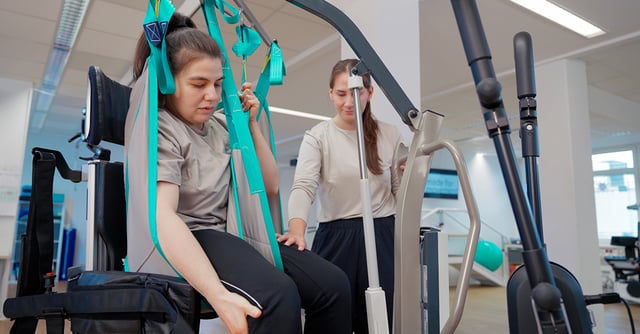
Jul 10, 2025How to transfer the user in and out of the Innowalk

Back to Blog Overview
Innowalk is a dynamic standing device that enables movement while standing for individuals with limited mobility. Before the benefits of dynamic standing can be enjoyed, it’s essential to ensure safe and smooth transfer in and out of the device. The following tips will guide you on how to do this!
In this article, you can read about:
- What is the Innowalk?
- Who is it for?
- What is the difference between Innowalk and Innowalk Pro?
- Who is this guide for?
- What to do before transferring?
- Transfer methods without hoist
- Transfer metods with hoist
- Attach necessary accessories
- Transfer out of the Innowalk
- We are here to support you
What is the Innowalk?
The Innowalk is a unique motorised dynamic standing device, that enables children, young people and adults with moderate to profound physical disabilities or complex movement disorders to access movement and physical activity. It provides safe, guided, repetitive movement by supporting the body in an upright position, offering optimal weight-bearing and dynamic standing. The Innowalk can be used regardless of independent standing ability.
Who is it for?
Dynamic standing in the Innowalk is suitable for individuals with different diagnoses, such as:
- Cerebral Palsy
- Acquired Brain Injury
- Spinal Muscular Atrophy
- Muscular Dystrophy
- Syndromes
- Stroke
- Spinal Cord Injury
- Multiple Sclerosis
- Other conditions affecting independent standing and walking
What is the difference between the Innowalk and the Innowalk Pro?
Innowalk
Innowalk is designed for individual use and is set up to meet the individual requirements. Adjustments are done accordingly due to growth or functional changes. An individual device is typically used in a home environment.
Innowalk Pro
Innowalk Pro is the professional version of the Innowalk and is designed for use by multiple people. A therapist or other trained personnel sets up the device for the individual. The device is typically used in clinics and hospital settings, rehabilitation centres, therapy facilities or special school settings.
Who is this guide for?
This guide is for:
- Healthcare professionals (physiotherapists, occupational therapists, etc.)
- Family caregivers
- Support staff in schools or care facilities
- Individual Innowalk users
What to do before transferring?
Before transferring you should make sure:
- The device is powered on
- A pre-check has been completed (scan the QR code on the headrest on the Innowalk 2 to access a pre-check guide online or refer to the user manual)
Before you start transferring the person into the device, you need to do the following:
- Open all straps and swing out the chest supports
- Position the foot plate on the entrance side in lowest position in the walking cycle
- Lower and swing away the leg support
- If using the swivel seat, turn it to preferred entrance side for easier access.
See video below:
Transfer Methods without hoist
Manual lifting transfer (for small children)
Small children can be transferred into the Innowalk by lifting. We recommend using appropriate transfer techniques, such as:
- Positioning the person close to the transfer surface
- Use a wide and stable base of support, bending at the knees and hips (not your back), and engage leg muscles for lifting
- Avoid twisting
The use of hoist should be considered to limit the load on the caretaker.
When the child has been transferred to the seat of the Innowalk:
- Close the chest supports and attach the chest strap. This will secure the individual in a safe position.
- If the swivel seat has been used, increase the seat height and swivel the seat to forward facing position.
- Position the feet on the foot plates. Make sure the heel is all the way back and in contact with the heel cup. Secure the straps over the feet.
- Secure the leg supports
- Attach the guide-straps to the leg supports and tighten the strap to defined length
- Move the user from sitting to defined standing position
- Secure the hip belt once in standing position and start the movement
See video below:
Standing transfer (for weight-bearing users)
If the individual has the ability to weight bear, standing transfer can be used. The person can either step to pivot or a turn table can be used to pivot from their position in the wheelchair into the Innowalk seat.
- Make sure you adjust seat to preferred height for easy transfers
- Once seated follow the procedure above to secure the user safely
See video below:
Individual transfer
If the user is able to independently transfer directly from the wheelchair the following procedure can be used:
- Adjust the seating height to the level of the wheelchair
- Make sure the leg support is lowered on the entrance side
- Once seated follow the procedure above to secure the user safely
See video below:
Transfer Methods with hoist
To ensure safe transfer for both the person using the Innowalk, but also for the person supporting them, we recommend using a hoist.
When transferring with a mobile hoist, it may be necessary to use the tilt function of the Innowalk to fit the wheels of the hoist underneath the device. Additionally, the tilt function facilitates easier positioning of the individual on the seat, as it provides a slightly reclined posture for more efficient placement of the hips.
- Once seated follow the procedure above to secure the user safely
- Slings can remain on during use – just ensure they are clear of the moving parts
See the two videos below:
Attach necessary accessories
The Innowalk offers a range of accessories that can be tailored to individual needs. These can be attached while the user is either sitting or standing.
Arm Movement Handles
These handles enable coordinated arm and leg movements, promoting full-body activity while standing. For users with limited grip strength, hand fixation gloves can be used in combination with the handles.

Tray
The tray is simple to attach and can be adjusted in both height and angle. It provides support for the hands and arms, enhancing stability, and can also be used for various activities. The tray can be swung to the side for easy access.

Shoulder straps
Designed to support the upper body, the shoulder straps are easily fastened to the chest support and the back of the column. They are especially useful for individuals who need extra upper body stability.

Neck Collar
These supports are designed to assist individuals with limited head control by providing gentle stabilisation of the head and neck during use.

Transfer out of the Innowalk
When the person has completed the session in the Innowalk and it is time to assist them to transfer out, you should remember the following:
- Release the hip belt before lowering the person into sitting
- Release the straps over the feet
- Release the guide-strap and swing away and lower the leg supports
If swivel seat is used for more independent transfer
- Turn the swivel seat to preferred side
- Lower the seat for preferred transfer position
- Release the chest support
- Transfer the person out of the device
If hoist is used for transfer
- Attach the sling to the hoist
- Release the chest support
- Transfer the person out of the device
We are here to support you
If you need any support or training on how to best transfer the user into the Innowalk you can reach out to us.
See our quickguide for the Innowalk here.


Rikke Damkjær Moen brings many years of experience as clinical physiotherapist to the Made for Movement team. Her mission is to ensure that everybody, regardless of mobility problems, should be able to experience the joy and health benefits of physical activity. As our Medical Manager, Rikke is passionate about sharing knowledge so that individuals with special needs, families, and clinicians can discover the possibilities and solutions provided by Made for Movement.

